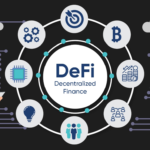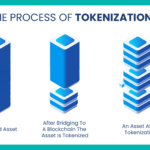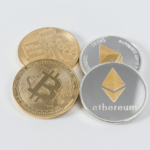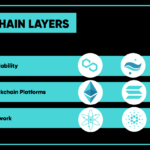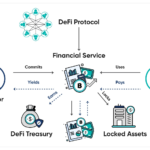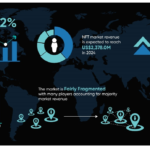Introduction
In an era defined by rapid technological advancement, the landscape of digital asset management is on its way to a deep transformation. The convergence of digital innovations and financial services has pushed the digital asset market into a new era of possibilities, challenging traditional paradigms and reshaping the way wealth is managed.
As we stand at the forefront of this digital revolution, it is imperative to embark on a comprehensive exploration of the technological evolution unfolding in digital asset management. This white paper seeks to delve deep into the intricacies of this paradigm shift, dissecting the latest trends, emerging technologies, and their implications for the future of wealth management.
Through rigorous analysis and insightful observations, we aim to provide stakeholders with a better understanding of how digitalization is revolutionizing the industry and how they can leverage these advancements to navigate the ever-expanding horizons of wealth management successfully.
The Challenges Of Digital Asset Investments
Security Concerns: Safeguarding Digital Assets
One of the foremost challenges in digital asset management revolves around security concerns. Unlike traditional assets, digital assets are susceptible to various cyber threats, including hacking and theft. The decentralized nature of many digital assets, likecryptocurrencies, aggravates these vulnerabilities.
The lack of regulatory oversight further increases the security risks associated with digital assets. To address these concerns, robust security measures must be implemented, including encryption protocols, multi-factor authentication, and cold storage solutions. Education and awareness initiatives are crucialto provideinvestors with the knowledge necessary to protect their digital assets effectively.
Lack of Transparency: Assessing Risk in an Opaque Market
Transparency is essential for investors to make informed decisions and assess the risk-return profile of digital assets accurately. However, the cryptocurrency market presents challenges in obtaining reliable information about asset fundamentals, market dynamics, and the activities of market participants.
Unlike publicly traded companies that are required to disclose financial information and adhere to reporting standards, many cryptocurrency projects operate in a decentralized manner, making it difficult to verify the accuracy of information and assess the credibility of project teams.
The prevalence of misinformation, market manipulation, and pump-and-dump schemes further undermines trust and transparency in the digital asset market. Investors may struggle to distinguish between legitimate projects with long-term viability and speculative assets driven by hype and speculation. This is why conducting thorough due diligence becomes necessary for investors seeking to navigate the complex landscape of digital asset investment.

Volatility: Riding the Roller Coaster
One of the most prominent characteristics of the digital asset market is its extreme volatility. Prices of cryptocurrencies such as Bitcoin, Ethereum, Solana, and others can fluctuate wildly within short periods, making it a roller coaster ride for investors.
While volatility can present opportunities for substantial gains, it also poses significant risks, as prices can decrease just as quickly as they rise. This unpredictability makes it challenging for investors to devise effective strategies for managing risk and preserving capital. In such circumstances, it’s always better to hire investment consultants from a reputable company like Kenson Investments.
Moreover, the interconnected nature of the cryptocurrency market means that the volatility of one asset can spill over into others, amplifying market-wide fluctuations. Even diversified portfolios may not provide adequate protection during times of heightened volatility.
Investors must remain vigilant and prepared to adjust their positions swiftly in response to market movements to mitigate the adverse effects of volatility on their investment portfolios. If you need technical guidance about investing in Bitcoin, altcoins, or stablecoins, the team at Kenson Investments can help you at every step of the process.
Interoperability Issues: Bridging Fragmented Systems
Another significant hurdle in digital asset management is the interoperability issues. As the digital asset landscape continues to expand, various platforms and protocols have emerged, each with its own set of standards.
This complicates the seamless transfer and exchange of digital assets between different ecosystems, leading to inefficiencies and bottlenecks. Interoperability standards like cross-chain compatibility are essential to facilitate frictionless interoperability between digital asset systems. Collaboration among industry stakeholders is also crucial to establishing a unified framework for digital asset management.
Regulatory Uncertainty: Navigating Legal and Compliance Challenges
In the realm of digital asset management, navigating regulatory uncertainty poses a significant challenge for investors. The regulatory landscape surrounding digital assets is constantly evolving, with policymakers grappling to keep pace with the rapid pace of technological innovation.
As a result, legal and compliance requirements vary widely across jurisdictions, creating a complex regulatory environment fraught with ambiguity and inconsistency. To address these challenges, collaboration between industry participants and regulators is essential to establish clear regulatory frameworks that promote innovation while safeguarding against illicit activities. The recent approval of Bitcoin ETF from the SEC is a step ahead in regulating the digital asset market and attracting institutional investors.
Scalability Constraints: Meeting the Demands of a Growing Ecosystem
Scalability constraints pose a formidable challenge to digital asset management, particularly as the adoption of digital assets continues to accelerate. Scalability encompasses various aspects, including network capacity and infrastructure scalability.
As transaction volumes increase and network congestion intensifies, scalability issues can impede the efficiency and reliability of digital asset management systems. Scalability solutions are essential to address these challenges and ensure the scalability of digital asset management infrastructure. Investments in robust infrastructure and technological innovations are crucial to accommodate the growing demands of an expanding digital asset ecosystem.
Metadata Management: Crucial For Informed Investment Strategies
Metadata management is a critical aspect of digital asset management, yet it presents numerous challenges for investors. One of the primary obstacles is maintaining consistent and accurate metadata across a diverse range of assets.
Different types of assets may require different metadata systems, and ensuring uniformity can bechallenging. Metadata may become outdated over time, especially in dynamic environments where assets are frequently created or modified. As an investor, you must keep a close eye on metadata to make informed investment decisions.

Digital Asset Investment Options
Bitcoin
Bitcoin has revolutionized the world of finance when it was introduced in 2009. It operates on a decentralized network called blockchain, which ensures transparency and security of transactions. Bitcoin is often referred to as digital gold because of its scarcity and store of value properties. It has a fixed supply cap of twenty-one million coins, making it resistant to inflationary pressures caused by central banks.
One of the key features of Bitcoin is its decentralization, meaning any single entity doesn’t control it. Transactions are peer-to-peer, eliminating the need for intermediaries like conventional banks.
Bitcoin’s volatility has been a subject of debate since its inception. While some view it as a drawback, others see it as an opportunity for speculative trading and investment. Its price fluctuations are influenced by various factors such as market demand, regulatory developments, macroeconomic trends, and investor sentiment.
The graph below clearly marketsBitcoin price fluctuations. Over five years, Bitcoin price has increased from 4110 to 52,345, which shows the high potential of cryptocurrency investments.

Despite its volatility, Bitcoin has gained widespread acceptance as a legitimate asset class. It is increasingly being adopted by institutional investors and incorporated into traditional investment portfolios as a hedge against rising inflation and economic uncertainty. The emergence of Bitcoin futures and options markets has provided avenues for more complex trading strategies.
Bitcoin has also seen growing interest as a medium of exchange for daily transactions. Numerous merchants and businesses now accept Bitcoin as payment, further enhancing its utility and mainstream acceptance.
Bitcoin remains the most prominent and influential digital asset in the cryptocurrency ecosystem. Its impact extends beyond the realms of finance, sparking discussions about the future of money, decentralization, and the role of technology in reshaping global economies.
Altcoins
Altcoins refer to any cryptocurrency other than Bitcoin. Since the launch of Bitcoin, thousands of alternative cryptocurrencies have been created, each with its unique features and use cases. Altcoins serve various purposes, including improving upon Bitcoin’s limitations, experimenting with new technologies, and addressing specific market needs.
One category of altcoins seeks to enhance Bitcoin’s functionality by introducing features such as faster transaction speeds, increased scalability, or enhanced privacy. Examples include Litecoin, which offers quicker block generation times and lower transaction fees compared to Bitcoin.
Another category of altcoins focuses on specific industries, catering to niche markets and applications. For example, Ethereum is a decentralized platform that enables the creation of smart contracts and decentralized applications (DApps). Its flexibility has led to the proliferation of various tokens and projects built on its blockchain, spanning domains like decentralized finance (DeFi), non-fungible tokens (NFTs), and decentralized autonomous organizations (DAOs).
While altcoins offer diversification opportunities and innovation within the cryptocurrency space, they also pose risks due to their speculative nature, lack of regulation, and potential for scam projects. Investors should conduct thorough research before investing in altcoins, considering factors like project team credibility, technological innovation, market demand, and regulatory compliance.
While Bitcoin remains the dominant digital currency, altcoins contribute to the evolution of blockchain technology and the expansion of use cases beyond conventional finance.
Stablecoins
Stablecoins have emerged as a crucial component of the cryptocurrency ecosystem, offering a bridge between the volatility of traditional cryptocurrencies like Bitcoin and the stability of fiat currencies like the US dollar. These digital assets are designed to maintain a stable value relative to a specific reference asset or basket of assets, such as fiat currency, commodities, or other cryptocurrencies.
One of the primary use cases for stablecoins is facilitating seamless transactions and transfers within the cryptocurrency space. Investors use stablecoinsto preserve value during periods of market volatility or when transitioning between different cryptocurrencies. By holding stablecoins instead of fiat currency, users can avoid the delays and fees associated with traditional banking systems while retaining price stability.
Stablecoins also play a crucial role in enabling decentralized finance (DeFi) applications and services. DeFi platforms use smart contracts and blockchain technology to offer a wide range of financial services, including lending and trading, without the need for intermediaries. Stablecoins serve as the primary medium of exchange and unit of account within the DeFi ecosystem, providing liquidity and price stability for various decentralized protocols and applications.
Stablecoins facilitate cross-border payments, offering a more efficient and cost-effective alternative to traditional money transfer methods. By usingblockchain technology, stablecoin transactions can be processed quickly and securely, with lower fees compared to traditional remittance services. This has significant implications for individuals in regions with limited access to banking infrastructure, enabling them to participate in the global economy and access financial services.
Stablecoins come in various forms, including centralized and decentralized. Centralized stablecoins are issued and backed by a central entity like a financial institution or cryptocurrency exchange, with reserves held in bank accounts or other liquid assets. Decentralized stablecoins rely on algorithmic mechanisms stored on a blockchain to maintain their stability.
Despite their benefits, stablecoins also face challenges and regulatory scrutiny, regarding transparency and systemic risks. Regulatory authorities worldwide are increasingly focusing on stablecoin issuers and their compliance with existing financial regulations, raising questions about the future regulatory landscape for stablecoins.
Recommended Read: Stablecoins for Investment: The Path to Consistency in the Crypto World
NFTs
Non-Fungible Tokens (NFTs) have surged in popularity in recent years, transforming the way digital assets are bought, sold, and owned. NFTs are unique and indivisible digital assets stored on a blockchain. Each NFT represents ownership of a specific digital or physical itemlike artwork, music, videos, virtual real estate, and more.
One of the defining characteristics of NFTs is their ability to provide verifiable scarcity in the digital realm. Through blockchain technology, NFTs enable creators to tokenize their work, creating a digital certificate of ownership that can be traded on various online marketplaces. It has unlocked new revenue streams for artists, musicians, and other creators, allowing them to monetize their digital creations directly and build a closer connection with their audience.
NFTs have also sparked a wave of innovation in the art and entertainment industries, challenging traditional notions of ownership and intellectual property. Digital artists are using NFTs to sell limited edition artworks, while musicians are releasing exclusive albums as NFTs.
NFT marketplaces are also emerging to cater to the growing demand for digital collectibles, providing a decentralized and transparent environment for trading and showcasing NFTs. Investors who want to find out more about the NFT market can connect with investment consultants to kickstart NFT investments.
Despite the excitement surrounding NFTs, the market has faced criticism and scrutiny, particularly regarding environmental concerns, market speculation, and potential copyright infringement. The speculative nature of NFT investments has led to concerns about market bubbles and price manipulation.
The intersection of NFTs and copyright law has sparked debates about ownership and licensing. While NFTs offer creators new opportunities to monetize their work and retain control over their intellectual property, they also raise complex legal issues regarding ownership rights. As NFTs continue to evolve and gain mainstream acceptance, policymakers and industry stakeholders will need to address these challenges to ensure the long-term viability and integrity of the NFT market.
Recommended Read: NFT Investments: Short-Term Gains vs. Long-Term Growth

Derivatives
Derivatives are financial tools whose value is derived from the performance of an underlying asset. They help investors speculate on price movements, hedge against risks, and manage exposure to various asset classes without owning the underlying assets.
One of the most common types of derivatives is futures contracts, which obligate an investor to trade an asset at a predetermined price on a specified future date. Futures contracts are widely used by investors to hedge against price fluctuations in commodities and currencies.
Another popular derivative tool is options contracts, which provide the buyer with the right, but not the obligation, to buy or sell an asset at a specified price within a predetermined time. Options are valued based on factors like the underlying asset’s price, time to expiration, and interest rates. You can use options for speculation, hedging, and risk management purposes.
Derivatives include other instruments like swaps and forwards, each serving specific risk management and investment objectives. Swaps involve the exchange of cash flows based on predetermined terms, allowing parties to manage interest rates or credit risk.
Forwards are customized contracts between two parties to buy or sell an asset at a future date at an agreed-upon price. Structured products combine multiple derivatives and traditional securities to create tailored investment strategies with specific risk-return profiles.
Understanding derivatives and efficiently investing can be tricky for new investors, which is why you must hire investment experts to help you at every step.
RWAs
Real-world assets (RWAs) are traditional, tangible assets that are tokenized and represented on a blockchain. By digitizing real-world assets, blockchain technology enables fractional ownership and enhanced transparency for a wide range of assets, including real estate and commodities. RWAs bridge the gap between traditional finance and blockchain technology, providing new investment opportunities and streamlining asset management processes.
One of the primary benefits of tokenizing real-world assets is increased accessibility and liquidity for investors. Investing in real estate or other tangible assets requires significant capital, long-term commitments, and complex legal processes.
However, by tokenizing real-world assets, investors can purchase fractional ownership stakes in high-value assets, enabling them to diversify their portfolios and access previously inaccessible markets.Tokenization also reduces the barriers to entry for retail investors, showcasing access to investment opportunities and expanding the pool of potential capital.
Tokenizing real-world assets offers greater transparency and efficiency in asset management and trading. Blockchain technology provides an excellent record of ownership and transaction history, eliminating the need for intermediaries like banks and brokers.
Smart contracts, self-executing contracts coded on the blockchain, automate the execution of contractual agreements like rent payments, dividends, and revenue sharing, enhancing operational efficiency and reducing administrative costs.
Tokenization can unlock liquidity for illiquid assets, like real estate and private equity, by enabling fractional ownership and secondary market trading. Investors can trade tokens representing real-world assets on decentralized exchanges (DEXs), providing a more efficient and transparent marketplace for buying, selling, and exchanging assets. This liquidity premium can result in lower capital costs and higher valuations for tokenized assets, benefiting investors and asset owners.
Futures Trading
Futures trading is a popular form of derivative trading that involves buying or selling contracts to trade an underlying asset at a predetermined price on a specified future date. Futures contracts are standardized agreements traded on regulated exchanges, facilitating liquidity and risk management for a wide range of commodities and financial instruments. Investors can use futures contracts to profit from price movements, hedge against risks, and diversify their portfolios.
One of the primary advantages of futures trading is its ability to provide leverage, allowing traders to control a larger position with a smaller initial investment. By only paying a fraction of the contract’s value, investors can increase their potential returns. This leverage enables investors to capitalize on short-term price movements and generate hefty profits with relatively small capital. However, it also increases the risk of losses, as investors may incur substantial losses if the market moves against their positions.
Another key benefit of futures trading is its role in price discovery and risk transfer. Futures markets provide a transparent platform for buyers and sellers to transact. The prices of futures contracts are influenced by factors like supply and demand dynamics, geopolitical events, and economic indicators, providing valuable insights into market sentiment and trends. Futures contracts serve as risk management tools, allowing investors to hedge against price volatility and mitigate exposure to adverse market conditions.
Diving into the futures market for new or even experienced investors can be tricky, which is why it’s always better to hire consultants who can guide you through the complexities of futures trading.
Recommended Read: Exploring the Advantages of Futures Trading for Investors
How To Handle Digital Asset Investments
Research and Due Diligence
Making profitable digital asset investments requires a solid foundation of research and due diligence. Here are some key steps to consider:
- Market analysis: Before diving into any investment, you must grasp the broader market trends and dynamics. It involves understanding the macroeconomic factors influencing digital assets, like global economic conditions and technological advancements. Analyzing market sentiment through sentiment analysis tools or social media monitoring can also provide valuable insights into investor sentiment. You can also analyze the fear & green index to analyze how the digital asset market is performing.

- Asset evaluation: Once you have a grasp of the market, consider analyzing individual assets. Evaluate the fundamentals of the digital asset you’re interested in, starting with its underlying technology. Assess the project’s whitepaper and roadmap to analyze its potential for long-term success. Evaluate the team behind the project, their experience, and their track record in the industry. Community support and engagement are also essential factors to consider, as they can indicate the project’s level of adoption and potential for growth.
- Risk assessment: Every investment carries a certain level of risk, and digital assets are no exception. You must assess and manage these risks effectively. Diversification is a key risk management strategy, spreading your investment across different assets to mitigate the impact of any single asset’s poor performance. Consider employing risk management tools like stop-loss orders to protect your capital and minimize losses.
- Technical analysis: Technical analysis involves analyzing price charts and market data to identify patterns that can inform trading decisions. Utilize technical analysis tools to identify potential entry and exit points. Pay attention to resistance levels, trend lines, and chart patterns to anticipate price movements and make effective trading decisions.
- Stay informed: The digital asset market is constantly evolving, with new developments and trends emerging regularly. Stay informed by following reputable sources like industry news websites and official project announcements. Engage with the community through online forums and social media channels to stay updated on the latest developments.
Portfolio Management Strategies
Effective portfolio management is also essential for maximizing returns and minimizing risk in digital asset investments. Find out how investors can manage digital asset portfolios:
- Diversification: Diversification helps reduce the overall risk of your portfolio by ensuring that a single asset’s poor performance doesn’t significantly impact your overall investment returns. Consider diversifying across different types of digital assets, like Bitcoin, stablecoin, and NFTs, as well as across different sectors within the digital asset space.
- Asset allocation: Asset allocation involves determining the optimal mix of assets in your investment portfolio based on your investment goals. Allocate your investment capital across various digital assets based on their risk-return profiles and correlation with other assets in your portfolio. Rebalance your portfolio frequently to maintain your desired asset allocation and adapt to changing market conditions.
- Risk management: Risk management is essential for protecting your investment capital and minimizing losses in the event of negative market movements. Consider the potential risks associated with each digital asset, including volatility, liquidity risk, and security risk, and take appropriate measures to mitigate these risks.
- Long-term vs. short-term investments: Decide whether you want to focus on long-term investments or short-term trading strategies based on your investment objectives. Long-term investors may prioritize assets with strong fundamentals and hold them for an extended period to capitalize on long-term growth potential. Short-term traders may take advantage of short-term price fluctuations and market inefficiencies to generate quick profits through active trading strategies.
- Rebalancing:Always review and rebalance your investment portfolio to ensure it remains aligned with your investment goals and risk tolerance. Rebalancing involves buying or selling assets within your portfolio to restore your desired asset allocation.
Staying Ahead of the Curve
To stay ahead of the curve in the fast-paced world of digital asset investments, it’s crucial to continually adapt and innovate. Learn more about some strategies to help investors stay ahead:
- Continuous learning: The digital asset market is constantly evolving, with new technologies, trends, and investment opportunities emerging regularly. Stay ahead by continuously educating yourself about blockchain technology, cryptocurrencies, decentralized finance (DeFi), non-fungible tokens (NFTs), and other emerging trends.
- Networking: Build relationships with other investors, developers, and industry professionals to exchange ideas and collaborate on investment opportunities. Networking can provide valuable opportunities for learning, collaboration, and discovering new investment opportunities that you may not have otherwise encountered.
- Adaptability: The digital asset market is highly dynamic and constantly evolving, with new technologies and regulations shaping the landscape. Be adaptable and open-minded in your investment approach, willing to pivot and adjust your strategies based on changing market conditions. Embrace new technologies and investment opportunities, and be proactive in exploring innovative ways to generate returns and manage risks in the digital asset space.
- Innovation: Keep an eye on new projects, platforms, and protocols that have the potential to disrupt traditional industries and create new value propositions. Consider investing in early-stage projects or participating in token sales and Initial Coin Offerings (ICOs) to capitalize on emerging opportunities and potential for high returns.
Technical Analysis and Market Timing
Technical analysis plays a crucial role in making profitable digital asset investments by helping investors understand market trends and identify potential entry and exit points. This approach involves examining historical price data and market statistics to predict future price movements.
Investors can use chart patterns, which provide visual representations of investor behavior. Common chart patterns include support and resistance levels, trend lines, and head & shoulders patterns. By recognizing these patterns, investors can anticipate potential price movements and make informed trading decisions based on market psychology.
Timing is critical in digital asset investments, as buying and selling at the right time can impact investment returns. Technical analysis can help investors identify optimal entry and exit points based on market trends and price patterns. By analyzing price charts and technical indicators, investors can develop trading strategies that capitalize on short-term price fluctuations and market inefficiencies.
Embracing Emerging Trends and Technologies
In the rapidly evolving landscape of digital asset investments, embracing emerging trends and technologies is essential for staying ahead of the curve and capitalizing on new opportunities. Here are some emerging trends and technologies to watch:
- Decentralized Finance (DeFi): DeFi has emerged as one of the most exciting and innovative sectors within the digital asset space, offering decentralized alternatives to traditional financial services. DeFi platforms create open and transparent financial systems that are accessible to anyone with an internet connection.
- BlockchainInteroperability: Blockchain interoperability refers to the ability of different blockchain networks to communicate and interact with each other seamlessly. Interoperability solutions enable the transfer of assets and data across multiple blockchains, unlocking new possibilities for cross-chain asset transfers.
Social Sentiment Analysis and Community Engagement
Understanding social sentiment and actively engaging with the community can provide valuable insights and opportunities for profitable digital asset investments. Social sentiment analysis involves monitoring discussions and sentiments expressed on social media platforms and online communities related to digital assets.
- Sentiment analysis tools: Investors can use various sentiment analysis tools to track and analyze social sentiment surrounding digital assets. These tools use Natural Language Processing (NLP) algorithms and machine learning techniques to analyze social media posts, news articles, and online discussions and extract sentiment indicators.
- Community engagement: Actively engaging with the community surrounding digital assets can provide investors with excellent insights. Participate in online forums, social media channels, and community-driven platforms dedicated to digital asset investments to connect with like-minded individuals, share insights, and stay updated on the latest developments.
- Community-driven investment opportunities: Community-driven investment opportunities such as Decentralized Autonomous Organizations (DAOs) and social trading platforms enable investors to participate in decision-making processes and investment strategies collectively.
- Social listening and engagement strategies: Develop social listening and engagement strategies to monitor social sentiment, engage with the community, and identify actionable insights and opportunities. By actively listening to the community, responding to inquiries, addressing concerns, and fostering open dialogue and collaboration, investors can build trust and credibility within the community and establish themselves as influential individuals in the digital asset space.
Regulatory Compliance
Navigating the regulatory landscape and ensuring compliance with applicable laws and regulations is crucial for mitigating risks and maintaining legal and regulatory compliance in digital asset investments. As the digital asset space evolves, regulators worldwide are increasingly scrutinizing digital asset investments and imposing regulatory requirements on market participants.
- Regulatory landscape: Stay informed about the regulatory landscape governing digital asset investments in your jurisdiction. Familiarize yourself with relevant laws and regulatory developments related to digital assets, cryptocurrencies, and securities regulations.
- Compliance obligations: Ensure compliance with applicable regulatory requirements and compliance obligations, including registration, licensing, and disclosure requirements imposed by regulatory authorities. Conduct thorough due diligence on digital asset projects to ensure compliance with applicable laws and mitigate legal, regulatory, and compliance risks associated with digital asset investments.
- Risk mitigation strategies: Develop risk mitigation strategies to identifyand manage legal digital asset risks. Implement robust compliance programs and risk management frameworks to mitigate regulatory risks and ensure adherence to applicable laws. Engage legal counsel and regulatory advisors to obtain legal and regulatory guidance and navigate complex regulatory requirements.
- Transparency and accountability: As an investor, consideradvocating for transparency and accountability in the digital asset space and support initiatives that promote fair and transparent markets. Collaborate with regulators, industry stakeholders, and market participants to develop regulatory frameworks that foster innovation, investor confidence, and market stability.
Psychological Factors in Investment Decision Making
Understanding and managing psychological factors is essential for making profitable digital asset investments. Investor behavior is influenced by emotions such as fear, greed, and overconfidence, which can lead to irrational decision-making.
Emotional Bias
Emotional bias can cloud judgment and lead investors to make impulsive or irrational decisions. Fear of missing out (FOMO) may drive investors to chase rising prices, while greed can lead investors to take excessive risks or overlook warning signs of a market bubble. Recognizing and managing emotional biases is crucial for maintaining discipline and making rational investment decisions.
Herd Mentality
Herd mentality is the tendency of investors to follow the crowd and mimic the actions of others during periods of market panic. When investors see others buying or selling a particular asset, they may feel compelled to follow suit, regardless of the underlying fundamentals or risks. This herd behavior can leadto market volatility and asset bubbles. As an investor, you must remain an independent thinker and conduct proper research rather than blindly following the crowd.
Confirmation Bias
Investors may selectively interpret news or market trends to fit their existing views, leading to overconfidence and a reluctance to consider alternative viewpoints. Overcoming confirmation bias requires staying open-minded and actively challenging one’s assumptions to make more informed investment decisions.
Overconfidence
Overconfidence can lead investors to overestimate their ability to predict market movements and underestimate the risks involved in digital asset investments. Investors may become overly confident in their trading strategies or ignore warning signs of a market downturn, leading to significant losses. It’s essential to remain humble and recognize the limitations of one’s knowledge and expertise when making investment decisions. Seeking advice from experienced investors, conducting thorough research, and practicing humility can help mitigate the risks of overconfidence.
Conclusion
This white paper provides a thorough exploration of the evolving landscape of wealth management, emphasizing the increasing significance of digital assets. As blockchain technology grows, opportunities for diversification and enhanced returns become more pronounced. By staying informed and embracing innovation, investors can position themselves to capitalize on the transformative potential of digital assets, driving growth and prosperity in the digital economy.



